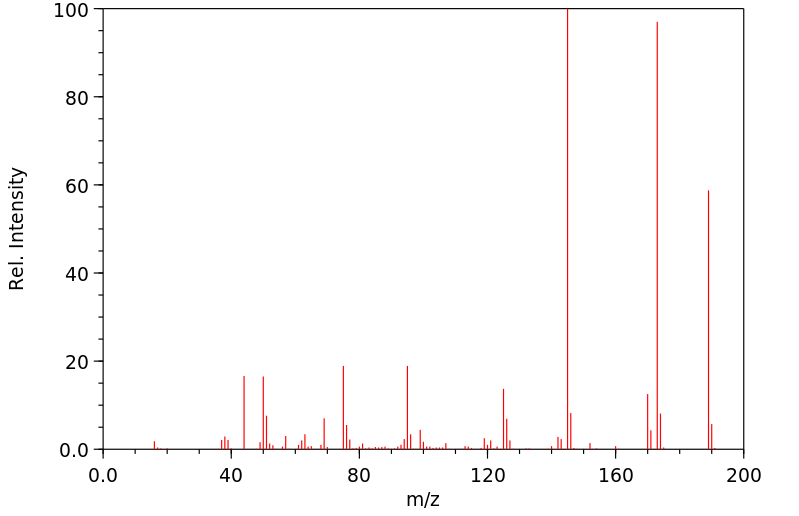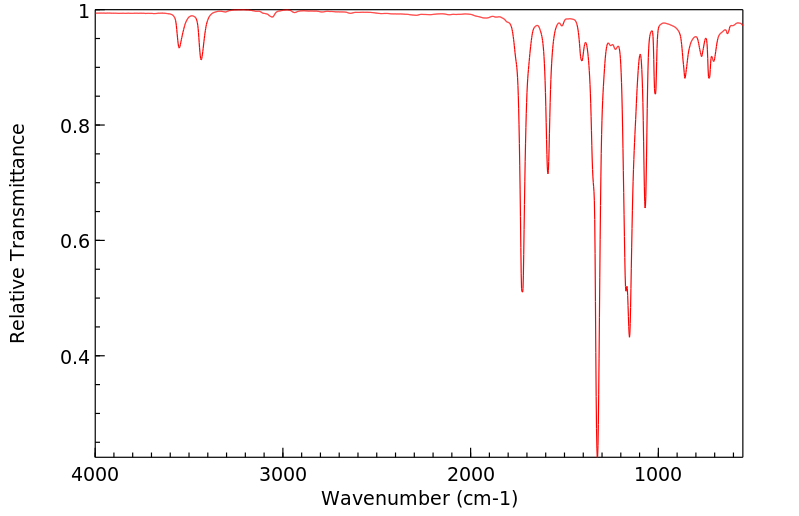4-(三氟甲基)苯甲酰胺 | 1891-90-3
中文名称
4-(三氟甲基)苯甲酰胺
中文别名
对三氟甲基苯甲酰胺;4-三氟甲基苯甲酰胺
英文名称
p-trifluoromethylbenzamide
英文别名
4-trifluoromethylbenzamide;p-Trifluormethylbenzamid;4-(Trifluoromethyl)benzamide
CAS
1891-90-3
化学式
C8H6F3NO
mdl
MFCD00007998
分子量
189.137
InChiKey
WEJHBEDHLLBJFW-UHFFFAOYSA-N
BEILSTEIN
——
EINECS
——
-
物化性质
-
计算性质
-
ADMET
-
安全信息
-
SDS
-
制备方法与用途
-
上下游信息
-
文献信息
-
表征谱图
-
同类化合物
-
相关功能分类
-
相关结构分类
物化性质
-
熔点:184-186 °C(lit.)
-
沸点:254.2±40.0 °C(Predicted)
-
密度:1.3305 (estimate)
-
稳定性/保质期:
如果按照规格使用和储存,则不会分解,未有已知危险反应,应避免与氧化物接触。
计算性质
-
辛醇/水分配系数(LogP):1.7
-
重原子数:13
-
可旋转键数:1
-
环数:1.0
-
sp3杂化的碳原子比例:0.125
-
拓扑面积:43.1
-
氢给体数:1
-
氢受体数:4
安全信息
-
危险等级:IRRITANT
-
危险品标志:Xi
-
安全说明:S26,S36,S37/39
-
危险类别码:R36/37/38
-
WGK Germany:3
-
海关编码:2924299090
-
危险类别:IRRITANT
-
危险性防范说明:P261,P305+P351+P338
-
危险性描述:H315,H319,H335
-
储存条件:请将贮藏器密封保存,在阴凉、干燥处存放,并确保工作环境有良好的通风或排气设施。
SDS
| Name: | 4-(Trifluoromethyl)benzamide 99% Material Safety Data Sheet |
| Synonym: | |
| CAS: | 1891-90-3 |
Synonym:
Section 2 - COMPOSITION, INFORMATION ON INGREDIENTS
| CAS# | Chemical Name | content | EINECS# |
| 1891-90-3 | 4-(Trifluoromethyl)benzamide | 99 | 217-571-9 |
Risk Phrases: 36/37/38
Section 3 - HAZARDS IDENTIFICATION
EMERGENCY OVERVIEW
Irritating to eyes, respiratory system and skin.The toxicological properties of this material have not been fully investigated.
Potential Health Effects
Eye:
Causes eye irritation.
Skin:
Causes skin irritation.
Ingestion:
May cause gastrointestinal irritation with nausea, vomiting and diarrhea.
Inhalation:
Causes respiratory tract irritation.
Chronic:
No information found.
Section 4 - FIRST AID MEASURES
Eyes: Flush eyes with plenty of water for at least 15 minutes, occasionally lifting the upper and lower eyelids. Get medical aid.
Skin:
Get medical aid. Flush skin with plenty of water for at least 15 minutes while removing contaminated clothing and shoes. Wash clothing before reuse.
Ingestion:
Never give anything by mouth to an unconscious person. Get medical aid. Do NOT induce vomiting. If conscious and alert, rinse mouth and drink 2-4 cupfuls of milk or water.
Inhalation:
Remove from exposure and move to fresh air immediately. If not breathing, give artificial respiration. If breathing is difficult, give oxygen. Get medical aid.
Notes to Physician:
Treat symptomatically and supportively.
Section 5 - FIRE FIGHTING MEASURES
General Information:
As in any fire, wear a self-contained breathing apparatus in pressure-demand, MSHA/NIOSH (approved or equivalent), and full protective gear. During a fire, irritating and highly toxic gases may be generated by thermal decomposition or combustion.
Extinguishing Media:
Use extinguishing media most appropriate for the surrounding fire.
Use water spray, dry chemical, carbon dioxide, or appropriate foam.
Section 6 - ACCIDENTAL RELEASE MEASURES
General Information: Use proper personal protective equipment as indicated in Section 8.
Spills/Leaks:
Vacuum or sweep up material and place into a suitable disposal container. Clean up spills immediately, observing precautions in the Protective Equipment section. Avoid generating dusty conditions.
Provide ventilation.
Section 7 - HANDLING and STORAGE
Handling:
Minimize dust generation and accumulation. Avoid contact with eyes, skin, and clothing. Keep container tightly closed. Avoid ingestion and inhalation. Use with adequate ventilation. Wash clothing before reuse.
Storage:
Keep container closed when not in use. Store in a tightly closed container. Store in a cool, dry, well-ventilated area away from incompatible substances.
Section 8 - EXPOSURE CONTROLS, PERSONAL PROTECTION
Engineering Controls:
Facilities storing or utilizing this material should be equipped with an eyewash facility and a safety shower. Use adequate ventilation to keep airborne concentrations low.
Exposure Limits CAS# 1891-90-3: Personal Protective Equipment Eyes: Wear appropriate protective eyeglasses or chemical safety goggles as described by OSHA's eye and face protection regulations in 29 CFR 1910.133 or European Standard EN166.
Skin:
Wear appropriate protective gloves to prevent skin exposure.
Clothing:
Wear appropriate protective clothing to prevent skin exposure.
Respirators:
A respiratory protection program that meets OSHA's 29 CFR 1910.134 and ANSI Z88.2 requirements or European Standard EN 149 must be followed whenever workplace conditions warrant respirator use.
Section 9 - PHYSICAL AND CHEMICAL PROPERTIES
Physical State: Crystalline powder
Color: white
Odor: Not available.
pH: Not available.
Vapor Pressure: Not available.
Viscosity: Not available.
Boiling Point: Not available.
Freezing/Melting Point: 184 - 186 deg C
Autoignition Temperature: Not available.
Flash Point: Not available.
Explosion Limits, lower: Not available.
Explosion Limits, upper: Not available.
Decomposition Temperature:
Solubility in water:
Specific Gravity/Density:
Molecular Formula: C8H6F3NO
Molecular Weight: 189.14
Section 10 - STABILITY AND REACTIVITY
Chemical Stability:
Stable under normal temperatures and pressures.
Conditions to Avoid:
Incompatible materials, dust generation, excess heat.
Incompatibilities with Other Materials:
Strong oxidizing agents.
Hazardous Decomposition Products:
Carbon monoxide, oxides of nitrogen, carbon dioxide, hydrogen fluoride gas.
Hazardous Polymerization: Has not been reported
Section 11 - TOXICOLOGICAL INFORMATION
RTECS#:
CAS# 1891-90-3 unlisted.
LD50/LC50:
Not available.
Carcinogenicity:
4-(Trifluoromethyl)benzamide - Not listed by ACGIH, IARC, or NTP.
Section 12 - ECOLOGICAL INFORMATION
Section 13 - DISPOSAL CONSIDERATIONS
Dispose of in a manner consistent with federal, state, and local regulations.
Section 14 - TRANSPORT INFORMATION
IATA
Not regulated as a hazardous material.
IMO
Not regulated as a hazardous material.
RID/ADR
Not regulated as a hazardous material.
Section 15 - REGULATORY INFORMATION
European/International Regulations
European Labeling in Accordance with EC Directives
Hazard Symbols: XI
Risk Phrases:
R 36/37/38 Irritating to eyes, respiratory system
and skin.
Safety Phrases:
S 26 In case of contact with eyes, rinse immediately
with plenty of water and seek medical advice.
S 37/39 Wear suitable gloves and eye/face
protection.
WGK (Water Danger/Protection)
CAS# 1891-90-3: No information available.
Canada
None of the chemicals in this product are listed on the DSL/NDSL list.
CAS# 1891-90-3 is not listed on Canada's Ingredient Disclosure List.
US FEDERAL
TSCA
CAS# 1891-90-3 is not listed on the TSCA inventory.
It is for research and development use only.
SECTION 16 - ADDITIONAL INFORMATION
N/A
制备方法与用途
化学性质:白色粉末状的固体。
上下游信息
-
上游原料
中文名称 英文名称 CAS号 化学式 分子量 N-羟基-4-(三氟甲基)苯甲酰胺 N-hydroxy-4-(trifluoromethyl)benzamide 40069-07-6 C8H6F3NO2 205.136 4-(三氟甲基)亚苯基肼 4-(trifluoromethyl)benzoic acid hydrazide 339-59-3 C8H7F3N2O 204.152 对三氟甲基苯甲醛 4-Trifluoromethylbenzaldehyde 455-19-6 C8H5F3O 174.122 4-(三氟甲基)苄胺 p-Trifluoromethylbenzylamine 3300-51-4 C8H8F3N 175.153 N-叔丁基-4-(三氟甲基)苯甲酰胺 N-(tert-butyl)-4-(trifluoromethyl)benzamide 91888-96-9 C12H14F3NO 245.244 4-三氟甲基苯甲酰氯 4-trifluoromethyl-phenyl acetyl chloride 329-15-7 C8H4ClF3O 208.567 —— N-phenyl 4-trifluoromethylbenzamide 347-80-8 C14H10F3NO 265.235 4-三氟甲基苯甲酸 4-trifluoromethylbenzoic acid 455-24-3 C8H5F3O2 190.122 4-三氟甲基苯甲脒 4-trifluoromethylbenzamidine 131472-28-1 C8H7F3N2 188.152 2-溴-4'-(三氟甲基)苯乙酮 2-bromo-1-[4-(trifluoromethyl)phenyl]ethanone 383-53-9 C9H6BrF3O 267.045 —— 2-methyl-2-(4-trifluoromethylbenzoylamino)propionic acid —— C12H12F3NO3 275.227 对三氟甲基苯乙烯 1-trifluoromethyl-4-vinyl-benzene 402-50-6 C9H7F3 172.15 - 1
- 2
-
下游产品
中文名称 英文名称 CAS号 化学式 分子量 N-甲基-4-(三氟甲基)苯甲酰胺 N-methyl-4-(trifluoromethyl)benzamide 65017-76-7 C9H8F3NO 203.164 —— N-chloro-4-trifluoromethylbenzamide —— C8H5ClF3NO 223.582 —— 4-(trifluoromethyl)benzoyl isocyanate 125931-36-4 C9H4F3NO2 215.131 N,N-二甲基-4-(三氟甲基)苯甲酰胺 N,N-dimethyl 4-(trifluoromethyl)benzamide 25771-21-5 C10H10F3NO 217.191 —— N-ethyl-4-(trifluoromethyl)benzamide 1379773-10-0 C10H10F3NO 217.191 —— N-(hydroxymethyl)-4-(trifluoromethyl)benzamide 134814-91-8 C9H8F3NO2 219.163 4-(三氟甲基)苄胺 p-Trifluoromethylbenzylamine 3300-51-4 C8H8F3N 175.153 —— N-benzyl-4-trifluoromethylbenzamide —— C15H12F3NO 279.262 —— N-butyl-4-(trifluoromethyl)benzamide —— C12H14F3NO 245.244 对甲苯酰胺 para-methylbenzamide 619-55-6 C8H9NO 135.166 —— N-hexyl-4-(trifluoromethyl)benzamide —— C14H18F3NO 273.298 —— 4-(trifluoromethyl)-N-[[4-(trifluoromethyl)phenyl]methyl]-benzenemethanamine 145126-91-6 C16H13F6N 333.276 —— N-benzyl-1-(4-(trifluoromethyl)phenyl)methanamine 79128-85-1 C15H14F3N 265.278 —— (E)-N-styryl-4-(trifluoromethyl)benzamide 1393689-79-6 C16H12F3NO 291.273 4-(三氟甲基)硫代苯甲酰胺 4-trifluoromethylbenzthioamide 72505-21-6 C8H6F3NS 205.204 —— 2-chloro-4-(trifluoromethyl)benzamide 254880-52-9 C8H5ClF3NO 223.582 4-三氟甲基苯甲酸 4-trifluoromethylbenzoic acid 455-24-3 C8H5F3O2 190.122 —— N-cinnamyl-4-(trifluoromethyl)benzamide —— C17H14F3NO 305.299 —— N-(octan-2-yl)-4-(trifluoromethyl)benzamide 1389327-45-0 C16H22F3NO 301.352 —— 4-trifluoromethylthiobenzoic acid 1514-09-6 C8H5F3OS 206.188 —— N-cyclohexyl-4-(trifluoromethyl)benzamide —— C14H16F3NO 271.282 N-(4-甲基苯基)-4-(三氟甲基)苯甲酰胺 N-(4-methylphenyl)-4-(trifluoromethyl)benzamide 447431-42-7 C15H12F3NO 279.262 —— N-(2-pyrimidinyl)-4-(trifluoromethyl)benzenecarboxamide 497059-99-1 C12H8F3N3O 267.21 —— (S)-N-(1-Phenylethyl)-4-(trifluoromethyl)benzamide —— C16H14F3NO 293.288 —— N-(1-p-tolylethyl)-4-trifluoromethylbenzamide —— C17H16F3NO 307.315 4-(三氟甲基)二苯甲酮 phenyl[4-(trifluoromethyl)phenyl]methanone 728-86-9 C14H9F3O 250.22 - 1
- 2
- 3
反应信息
-
作为反应物:描述:参考文献:名称:在无溶剂条件下,通过硫醇化和氧化二聚作用,从伯酰胺一锅两步合成 1,2,4-噻二唑:一种更环保的方法摘要:首次证明了在无溶剂的情况下,用劳森试剂(LR)和叔丁基过氧化氢(TBHP)从伯酰胺高效实用的一锅两步合成1,2,4-噻二唑。这种突破性且环保的方法利用了现成的原材料,并消除了反应过程中传统溶剂的使用。广泛的底物范围、在温和和无金属条件下出色的官能团耐受性、快速转化和出色的产率是该方法的基本特征。所有化合物均无需柱色谱法纯化。DOI:10.1039/d4ra03993a
-
作为产物:参考文献:名称:含有i Pr 2 P(CH 2)2 P i Pr 2配体的 Mn(i)有机金属,用于芳族腈的催化水合作用†摘要:报道了由锰分子化合物催化的芳族腈均匀水合的第一个例子。合成了Mn(I)有机金属fac -[(CO)3 Mn(dippe)(Z)] 1- n X 1- n(n = 0,1; Z = Br,OTf,PhCN; X = OTf)表征,并研究了它们的反应性。将种类fac -[(CO)3 Mn(dippe)(OTf)](2)用作基准苯甲腈(2 mol%2,THF / H 2)选择性水合的催化剂前体O 1:2 v / v,18 h,100°C)产生苯甲酰胺,分离产率为90%。将一系列(杂)芳族腈水合以合成相应的酰胺,产率非常好(88-94%)。同位素标记研究认为质子转移是决定速率的步骤。DOI:10.1039/c8cy00416a
文献信息
-
[EN] 1-AKAN-2-OL SUBSTITUTED PIPERAZINE AND PIPERIDINE COMPOUNDS<br/>[FR] COMPOSES PIPERAZINE ET PIPERAZINE 1-AKAN-2-OL SUBSTITUES申请人:CV THERAPEUTICS INC公开号:WO2005061470A1公开(公告)日:2005-07-07Disclosed are novel substituted heterocyclic derivatives having the structure of Formula (I): The compounds are useful for the treatment of various disease states, in particular cardiovascular diseases such as atrial and ventricular arrhythmias, intermittent claudication, Prinzmetal's (variant) angina, stable and unstable angina, exercise induced angina, congestive heart disease, diabetes, and myocardial infarction.揭示了具有以下结构的新型取代杂环衍生物(I)的化合物:这些化合物对于治疗各种疾病状态有用,特别是心血管疾病,如心房和心室心律失常,间歇性跛行,普林兹梅塔(变异)心绞痛,稳定和不稳定心绞痛,运动诱发性心绞痛,充血性心脏病,糖尿病和心肌梗死。
-
A novel oxidative procedure for the synthesis of benzamides from styrenes and amines under metal-free conditions作者:Muhammad Sharif、Jin-Long Gong、Peter Langer、Matthias Beller、Xiao-Feng WuDOI:10.1039/c4cc01054j日期:——An interesting procedure for the oxidative synthesis of amides from styrenes and amines has been developed. Various primary amides were formed in moderate yields (25–81%). Secondary amides can be produced in moderate yields as well (41–68%). Notably, no transition metal catalyst was needed for this transformation. This is the first example of oxidative transformation of styrenes to benzamides.
-
A general and practical oxidation of alcohols to primary amides under metal-free conditions作者:Xiao-Feng Wu、Muhammad Sharif、Jian-Bo Feng、Helfried Neumann、Anahit Pews-Davtyan、Peter Langer、Matthias BellerDOI:10.1039/c3gc40668g日期:——A general procedure for oxidation of both benzyl alcohols and alkyl alcohols to primary amides under catalyst free conditions has been developed. 34 examples of primary amides were produced from their corresponding alcohols in moderate to excellent yields. This is a practical procedure for primary amides synthesis; water and tert-butanol are the only by-products. A commercial drug, Piracetam, was prepared
-
Design, synthesis and fungicidal activity of N-substituted benzoyl-1,2,3,4-tetrahydroquinolyl-1-carboxamide作者:Peng Lei、Yan Xu、Juan Du、Xin-Ling Yang、Hui-Zhu Yuan、Gao-Fei Xu、Yun LingDOI:10.1016/j.bmcl.2016.03.085日期:2016.5excellent fungicidal activities, and the position of the substituents played an important role in fungicidal activities. Especially, compound 5n, exhibited better fungicidal activities than the commercial fungicide flutolanil against two tested fungi Valsa mali and Sclerotinia sclerotiorum, with EC50 values of 3.44 and 2.63 mg/L, respectively. And it also displayed good in vivo fungicidal activity against为了寻找具有高生物活性的新的铅化合物,采用连接活性亚结构法设计了一系列N-取代的苯甲酰基-1,2,3,4-四氢喹啉基-1-羧酰胺。由取代的苯甲酸按四个步骤合成目标化合物,并通过1 H NMR,IR光谱和元素分析确定其结构。体外生物测定结果表明,某些目标化合物表现出优异的杀真菌活性,且取代基的位置在杀真菌活性中起重要作用。特别是,化合物5n对两种测试真菌Valsa mali和Sclerotionia sclerotiorum的杀真菌活性比市售杀真菌剂氟苯尼更好。,其EC 50值分别为3.44和2.63 mg / L。而且它还显示出良好的针对核盘菌的体内杀真菌活性,其EC 50值为29.52 mg / L。
-
Suzuki–Miyaura Cross-Coupling of <i>N</i>-Acylpyrroles and Pyrazoles: Planar, Electronically Activated Amides in Catalytic N–C Cleavage作者:Guangrong Meng、Roman Szostak、Michal SzostakDOI:10.1021/acs.orglett.7b01575日期:2017.7.7The formation of C–C bonds from amides by catalytic activation of the amide bond has been thus far possible by steric distortion. Herein, we report the first example of a general Pd-catalyzed Suzuki–Miyaura cross-coupling of planar amides enabled by the combination of (i) electronic-activation of the amide nitrogen in N-acylpyrroles and pyrazoles and (ii) the use of a versatile Pd-NHC catalysis platform
表征谱图
-
氢谱1HNMR
-
质谱MS
-
碳谱13CNMR
-
红外IR
-
拉曼Raman
-
峰位数据
-
峰位匹配
-
表征信息
同类化合物
(βS)-β-氨基-4-(4-羟基苯氧基)-3,5-二碘苯甲丙醇
(S,S)-邻甲苯基-DIPAMP
(S)-(-)-7'-〔4(S)-(苄基)恶唑-2-基]-7-二(3,5-二-叔丁基苯基)膦基-2,2',3,3'-四氢-1,1-螺二氢茚
(S)-盐酸沙丁胺醇
(S)-3-(叔丁基)-4-(2,6-二甲氧基苯基)-2,3-二氢苯并[d][1,3]氧磷杂环戊二烯
(S)-2,2'-双[双(3,5-三氟甲基苯基)膦基]-4,4',6,6'-四甲氧基联苯
(S)-1-[3,5-双(三氟甲基)苯基]-3-[1-(二甲基氨基)-3-甲基丁烷-2-基]硫脲
(R)富马酸托特罗定
(R)-(-)-盐酸尼古地平
(R)-(-)-4,12-双(二苯基膦基)[2.2]对环芳烷(1,5环辛二烯)铑(I)四氟硼酸盐
(R)-(+)-7-双(3,5-二叔丁基苯基)膦基7''-[((6-甲基吡啶-2-基甲基)氨基]-2,2'',3,3''-四氢-1,1''-螺双茚满
(R)-(+)-7-双(3,5-二叔丁基苯基)膦基7''-[(4-叔丁基吡啶-2-基甲基)氨基]-2,2'',3,3''-四氢-1,1''-螺双茚满
(R)-(+)-7-双(3,5-二叔丁基苯基)膦基7''-[(3-甲基吡啶-2-基甲基)氨基]-2,2'',3,3''-四氢-1,1''-螺双茚满
(R)-(+)-4,7-双(3,5-二-叔丁基苯基)膦基-7“-[(吡啶-2-基甲基)氨基]-2,2”,3,3'-四氢1,1'-螺二茚满
(R)-3-(叔丁基)-4-(2,6-二苯氧基苯基)-2,3-二氢苯并[d][1,3]氧杂磷杂环戊烯
(R)-2-[((二苯基膦基)甲基]吡咯烷
(R)-1-[3,5-双(三氟甲基)苯基]-3-[1-(二甲基氨基)-3-甲基丁烷-2-基]硫脲
(N-(4-甲氧基苯基)-N-甲基-3-(1-哌啶基)丙-2-烯酰胺)
(5-溴-2-羟基苯基)-4-氯苯甲酮
(5-溴-2-氯苯基)(4-羟基苯基)甲酮
(5-氧代-3-苯基-2,5-二氢-1,2,3,4-oxatriazol-3-鎓)
(4S,5R)-4-甲基-5-苯基-1,2,3-氧代噻唑烷-2,2-二氧化物-3-羧酸叔丁酯
(4S,4''S)-2,2''-亚环戊基双[4,5-二氢-4-(苯甲基)恶唑]
(4-溴苯基)-[2-氟-4-[6-[甲基(丙-2-烯基)氨基]己氧基]苯基]甲酮
(4-丁氧基苯甲基)三苯基溴化磷
(3aR,8aR)-(-)-4,4,8,8-四(3,5-二甲基苯基)四氢-2,2-二甲基-6-苯基-1,3-二氧戊环[4,5-e]二恶唑磷
(3aR,6aS)-5-氧代六氢环戊基[c]吡咯-2(1H)-羧酸酯
(2Z)-3-[[(4-氯苯基)氨基]-2-氰基丙烯酸乙酯
(2S,3S,5S)-5-(叔丁氧基甲酰氨基)-2-(N-5-噻唑基-甲氧羰基)氨基-1,6-二苯基-3-羟基己烷
(2S,2''S,3S,3''S)-3,3''-二叔丁基-4,4''-双(2,6-二甲氧基苯基)-2,2'',3,3''-四氢-2,2''-联苯并[d][1,3]氧杂磷杂戊环
(2S)-(-)-2-{[[[[3,5-双(氟代甲基)苯基]氨基]硫代甲基]氨基}-N-(二苯基甲基)-N,3,3-三甲基丁酰胺
(2S)-2-[[[[[((1S,2S)-2-氨基环己基]氨基]硫代甲基]氨基]-N-(二苯甲基)-N,3,3-三甲基丁酰胺
(2S)-2-[[[[[[((1R,2R)-2-氨基环己基]氨基]硫代甲基]氨基]-N-(二苯甲基)-N,3,3-三甲基丁酰胺
(2-硝基苯基)磷酸三酰胺
(2,6-二氯苯基)乙酰氯
(2,3-二甲氧基-5-甲基苯基)硼酸
(1S,2S,3S,5S)-5-叠氮基-3-(苯基甲氧基)-2-[(苯基甲氧基)甲基]环戊醇
(1S,2S,3R,5R)-2-(苄氧基)甲基-6-氧杂双环[3.1.0]己-3-醇
(1-(4-氟苯基)环丙基)甲胺盐酸盐
(1-(3-溴苯基)环丁基)甲胺盐酸盐
(1-(2-氯苯基)环丁基)甲胺盐酸盐
(1-(2-氟苯基)环丙基)甲胺盐酸盐
(1-(2,6-二氟苯基)环丙基)甲胺盐酸盐
(-)-去甲基西布曲明
龙蒿油
龙胆酸钠
龙胆酸叔丁酯
龙胆酸
龙胆紫-d6
龙胆紫








